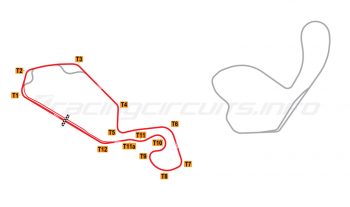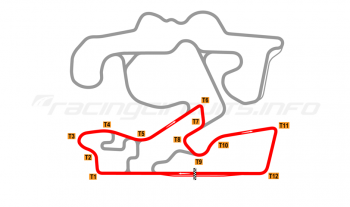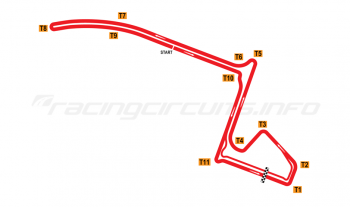Lausitzring
Circuit Overview
The Lausitzring (or DEKRA Lausitzring, as it is more properly known) is large racing and testing complex in eastern Germany, built on the site of a former coal mine and home to continental Europe's only oval superspeedway.
While the oval course initially hosted the CART Championship cars, it has been the infield road course which has proved the more enduring, hosting top level domestic and international racing.
The whole facility was purchased by German automotive testing giants DEKRA in 2017 but the circuit has continued to host motorsport events, while its research and development capabilities have continued to grow.
Circuit History
The idea for revitalising the mining-scarred landscape for motor sport use was first suggested in the mid-1980s, while the region was still part of Communist East Germany. Off-road motorcycle racing was already popular in the area and creating the country's first permanent circuit was a tempting prospect for political leaders. Plans began to be formulated but where ultimately put on hold by German reunification.
By the mid-1990s, new impetus was given to the project by the need to find a replacement for the AVUS street circuit in Berlin, which was coming to the end of its life thanks to the capital's increased traffic and general safety concerns. In 1991 a development company was established to find a suitable location, with the former Meuro open mine site eventually winning out. In 1995, blessing for the project was given by the State government and the detailed planning began.
Groundbreaking on the new facility began in June 1998 but protests by a residents group brought proceedings to a halt two months later. Equally vociferous demonstrations by motorsport enthusiasts saw the green light given for construction to resume and, over the next 18 months the circuit complex began to emerge. The foundation stone of the main grandstand was laid in May 1999, followed in June by the first asphalting work. The final topping-out ceremony was held on 2 December 1999.
The circuit complex was on a scale not seen elsewhere in Europe. At its heart was the two-mile tri-oval speedway, reminiscent in design to Pocono Raceway. A second oval – long and thin and just under four miles in length – sat next to the main course, intended as a test facility but which could also be connected to the main infield road course to create a 7.5-mile 'langstrecke'. Overlooking the oval and infield road course was a giant main grandstand, which could seat 25,000 in its own right, while additional bleachers around the oval could seat another 95,000. Nothing about the project was small in scale and the budget reflected this; the total cost of construction was 158 million euros, with the state of Brandenburg providing 123 million euros.
An official opening ceremony, witnessed by 80,000 spectators, took place on 20 August 2000, with the circuit given the formal name of Eurospeedway Lausitz. The German IDM Superbike championship was first to test the new asphalt in competition a week later, followed a further seven days on by the DTM, though the second of two planned races had to be abandoned due to torrential rain. Both categories have gone on to be mainstays of the circuit's race calendar.
The first full season of competition was marked by a series of tragedies; in April, Formula One veteran Michele Alboreto was killed in a crash on test circuit, when a puncture saw his Audi R8 sports prototype flip into the barriers. Then a young marshal was killed during a test session in May when he was hit by a touring car. Finally, September's German 500 – the first CART Champ Car race on the oval, just a week after the September 11 atrocities – saw a truly horrifying crash as Alex Zanardi spun leaving the pits and was collected at almost full speed by Alex Tagliani. Zanardi survived but lost both his legs as a result.
In the middle of 2002, the circuit faced a crisis when the Bank of Berlin, whose subsidiary IBG was main shareholder of the Lausitzring, found itself a victim to a real estate scandal. This lead to the the circuit being placed in bankruptcy, with insolvency proceedings commencing in September. The CART Champ Car event was cancelled as a result, though other parts of the racing schedule remained intact. By the end of the year, the local courts granted a new beginning, with a fresh operating company taking control.
CART returned for one more event in 2003 before concluding that it would be better served concentrating on its domestic events, though the event did see the symbolic return of Alex Zanardi, who ran 13 laps of the oval in a modified car, thereby completing the laps he was denied by the crash. The tri-oval would see increasingly fewer races as the years continued; the UK-based ASCAR series came and went while the German F3 cars experimented with oval running in 2005 and '06.
With the road course assuming more prominence, the first significant track alterations came in 2005 with the addition of a new link road to create a 2.9 mile /3.4 km short course, used from this point on by the DTM. At the same time, several new series arrived; World Superbikes made their debut on the long motorcycle course, while the longer road course was used by the A1 GP Series.
In order to create a new overtaking opportunity and in a bid to cut out some of the first corner carnage that had blighted some DTM races, turn one of the road course was re-profiled for the 2007 season, becoming a tighter hairpin bend. The original more sweeping variant was still available for other series to use, in particular being generally felt to be more suited to motorcycle racing. The only other changes to the circuit infrastructure came a year later, with the decision to use the final corners of the motorcycle circuit as the pit lane entrance during car races – thus eliminating the problematic previous entrance, which saw drivers have to slow on the racing lane out of the final sweeping turn.
In 2012, the combined road and test course was used for racing for the first time, when the Rundstrecken-Challenge Nürburgring GT and touring car series ventured away from the Nordschliefe for the first time. The race on the 7.4 miles / 12 km course seemed generally to have been judged a success but has to date not yet been repeated, perhaps one difficulty being the relative remoteness of the spectators when compared with Nürburgring.
Nevertheless, the Lausitzring did appear to have found a firm footing on the German racing scene and the test facility has been well greeted by the country's motor manufacturers. It was the latter fact that proved tempting to vehicle testing firm DEKRA, which inked a deal in July 2017 to buy the whole facility. DEKRA took ownership from November, renaming it as DEKRA Lausitzring and turning the circuit into Europe's largest automotive testing facility.
While DEKRA does not itself promote motorsport events, the track remains available for hire by event promoters and racing has continued. The DTM and the IDM motorcycle championships are among those returning, alongside some smaller events.
Jump onboard
Circuit info
- EuroSpeedway Lausitz, Lausitzallee 1, 01998 Klettwitz, Germany
- +49 35754 33733
- Email the circuit
- Official website
Rate This Circuit
Votes: 5573
Plan a visit
Get your race tickets!
Brought to you with: 
We've teamed up with Motorsports Tickets to bring you the best deals for Formula One, MotoGP, Le Mans and more.














































